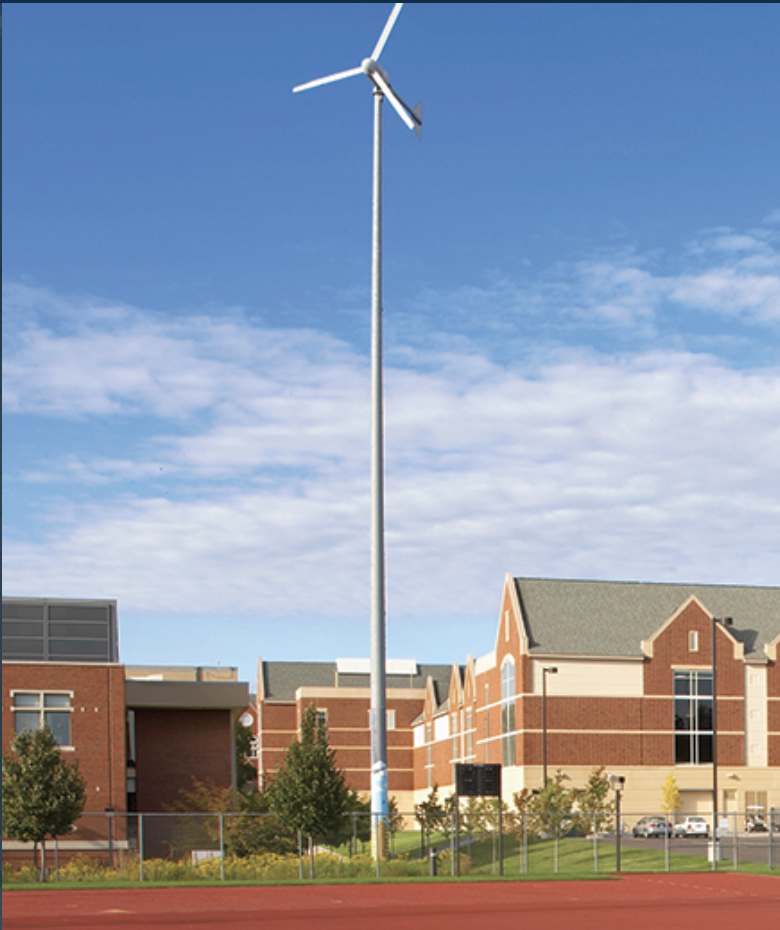Carbon Neutrality Efforts & Goals
Contact
Sustainability Office1657 Lincoln 651-696-6019
sustainability@macalester.edu
facebook twitter instagram

- Ever-Green Energy Report: Macalester continues to work towards carbon neutrality. In 2021 they collaborated with Ever-Green Energy to complete an analysis of steps that can be taken to further these goals.
- Photovoltaic (Solar Power): December 2015 brought Macalester its first photovoltaic installation located on the roof of Markim Hall. Panels were manufactured by tenKsolar and provide Markim Hall and campus with about 17,000 kWh of electricity each year. This avoids nearly 10 metric tons of CO2 from entering the atmosphere per year (saving $43,000 after 15 years, which can only increase as solar power becomes less expensive) Expected lifespan of thirty years.
- Wind Turbine: In April 2003, Macalester College installed a 10 kilowatt BWC Excel wind turbine – the first of its size in the City of St. Paul and one of the first on any college campus, which provides an educational opportunity for students, staff and faculty learn about wind energy, wind patterns, geography and the practicality of wind turbines in urban areas.
- Purchased Energy: Purchased electricity and heat make up 65 percent of Macalester’s greenhouse gas emissions. The Sustainability Plan includes a goal of investing in energy efficiency and switching to lower carbon fuel sources.
- Leonard Center: Home to Macalester athletics and the Health and Wellness office. When the old recreation center, with the gymnasium originally built in 1923, was demolished, 93.3% of the 15,171 tons of demolition waste was reused or recycled. This included materials such as bleachers, lockers, benches, casework, plumbing fixtures, saunas, hand dryers, and handrails to be reused by local residents, businesses, and a church. The most significant reuse was of the former fieldhouse that became a horse barn for the Maple Hills Stable Company in Monticello, MN. A meticulous deconstruction reused 100 tons of lumber and 10 arch beams as well as the copper wiring and conduit, fans, and lights from the fieldhouse to be used for the barn. The college also hired sustainability consultants to assist in the design of the new building, and the final design promotes significant energy reductions.
- Markim Hall: The first building in Minnesota higher education to achieve the United States Green Building Council’s Leadership in Energy and Environmental Design (LEED) Platinum standard. Platinum is the highest rating possible and Markim Hall was the first building in Minnesota Higher Education to meet this standard and the third building in Minnesota. The building optimizes daylight, utilized permeable pavers, and underground perforated pipes to help control stormwater runoff. Macalester then offsets all emissions through Markim’s electrical and on-site combustion footprint use through Renewable Choice Energy.
- Janet Wallace Fine Arts Center: A renovation which finished in January of 2019 gave the Fine Arts Center many sustainable additions: a daylight sensor that adjusts the building’s heat based on the amount of solar radiation; two stormwater-holding areas that help to filter building and parking lot runoff before it runs to the Mississippi River; large bird-safe windows on the south end of the building that let in lots of natural light; and, better roof and window insulation, allowing for a tighter building envelope that will provide a superior energy performance compared to the pre-renovation building.
- Facilities Energy Management Page